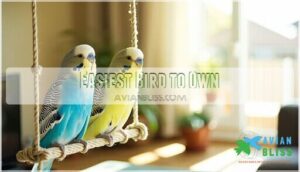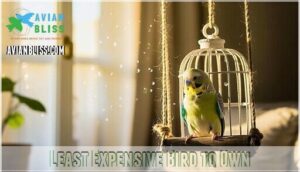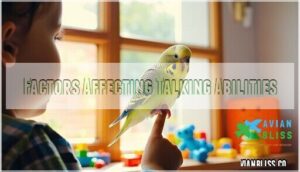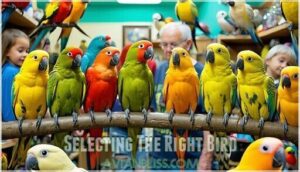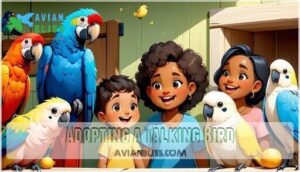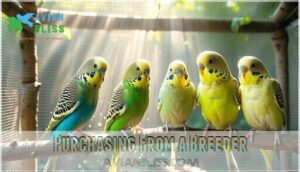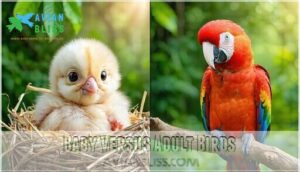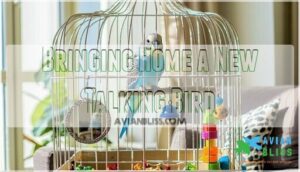This site is supported by our readers. We may earn a commission, at no cost to you, if you purchase through links.
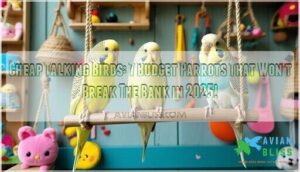 If you’re on the hunt for cheap talking birds, a budgerigar (or budgie) is your best bet.
If you’re on the hunt for cheap talking birds, a budgerigar (or budgie) is your best bet.
These small parrots are affordable, easy to care for, and surprisingly chatty if you’re patient with training.
Cockatiels, another budget-friendly option, can mimic simple whistles and phrases while charming you with their playful personalities.
Indian ringneck parakeets and lineolated parakeets are a step up in price but offer impressive speech abilities, especially with consistent interaction.
Remember, a bird’s ability to talk depends on its species, personality, and the time you spend teaching it.
Want to learn which bird fits your lifestyle best? Stay tuned!
Table Of Contents
- Key Takeaways
- Cheapest Talking Bird
- Easiest Bird to Own
- Least Expensive Bird to Own
- Talking Bird Breeds
- Factors Affecting Talking Abilities
- Selecting The Right Bird
- Adopting a Talking Bird
- Purchasing From a Breeder
- Baby Versus Adult Birds
- Bringing Home a New Talking Bird
- Frequently Asked Questions (FAQs)
- What are cheap talking birds?
- Which is the cheapest talking parrot?
- How do I Choose an affordable talking bird?
- What birds talk a lot?
- How much does a talking bird cost?
- What are the best cheap talking birds in Africa?
- What is a cheap talking bird?
- Are there any talking birds that sing well?
- What is the cheapest bird that talks?
- How much do talking birds cost?
- Conclusion
Key Takeaways
- Budgies are the best choice for cheap talking birds, costing as little as $10 and capable of mimicking 50+ words with consistent training.
- Cockatiels are budget-friendly at $50-$150 and excel at whistling but can also learn simple phrases with patience.
- Indian Ringneck Parakeets, priced at $250-$500, offer impressive speech clarity and can learn long phrases with daily interaction.
- Smaller species like budgies and lovebirds are perfect for beginners, requiring minimal space, low-maintenance care, and regular attention to thrive.
Cheapest Talking Bird
Looking for cheap talking birds that are easy on your wallet and big on charm? Meet the budgerigar, or budgie, the ultimate beginner bird in the affordable pet birds category.
Budgies deliver big personality and impressive chatter without breaking the bank—perfect feathered friends for first-time pet owners.
These tiny parrots, priced between $20-$50, stand out for their impressive talking skills, speech clarity, and ability to learn 50+ words with proper training. They’re low maintenance, making them perfect for first-time bird owners.
Budgies may be small, but they’re vocal powerhouses, mimicking words and simple phrases. While parrotlets and cockatiels offer unique talking abilities, they usually cost more.
Affordable and engaging, budgerigars are ideal if you’re starting out. These birds, like blue parakeets, also communicate using body language. They prove you don’t need to spend big to enjoy a companion with great vocabulary size!
Easiest Bird to Own
If you’re looking for a talking bird that’s easy to care for, Budgerigars and Lovebirds are fantastic options.
Budgerigars and Lovebirds are fun, low-cost companions, perfect for beginners seeking charm without high-maintenance care.
They’re low-maintenance, affordable, and adapt well to small spaces, making them ideal for beginners.
Budgerigar
Perched at the top of any affordable talking birds list, Budgerigars (budgies) offer impressive communication skills without emptying your wallet. At just $10-$35, these colorful Australian natives are perfect for first-time bird owners.
Your budgie can develop remarkable talking skills with consistent training:
- Male budgies typically demonstrate clearer speech than females, making them preferred for those seeking a talkative companion
- Daily 15-minute sessions can help your budgie learn up to 50+ words within months
- "Puck" the budgie earned a Guinness Record with an astounding 1,728-word vocabulary
- Morning practice yields better results as budgies are most alert after waking
- Repetition with enthusiasm helps budgies connect words with meaning
They’re ideal for apartments, requiring minimal space while delivering maximum personality. For additional resources, consider specialized talking training. Their speech clarity often surprises visitors, especially from such a tiny, affordable package.
Lovebirds
Lovebirds’ cheerful personalities offer big entertainment in small, affordable packages.
These colorful companions typically cost $50-$100, making them ideal budget-friendly talking birds.
- Lovebird Bonding: These social creatures form strong attachments through daily interaction, often following you around the house
- Lovebird Diet: They’re easy to feed with simple seed mixes, fresh fruits, and vegetables
- Lovebird Sounds: While not champion talkers, they communicate with distinctive chirps and can learn simple words
- Lovebird Colors: From vibrant peach-faced to elegant masked varieties, their plumage brightens any room
Despite their name, a single lovebird makes an affectionate, cheap talking bird for beginners.
Least Expensive Bird to Own
If you’ve been dreaming of a feathered friend that talks without emptying your wallet, budgerigars (budgies) are your answer. As the most affordable of all cheap talking birds, these little charmers cost just $10-$35 initially.
The initial costs are just the beginning of your budgie journey. Your cheap pet birds will need:
- A modest cage size (smaller than larger parrots)
- Basic food costs (about $10-15 monthly)
- Occasional vet care (annual checkups)
Other budget-friendly options include finches and canaries, though they won’t chat with you like budgies can. Parakeets average $10-$40, making them an accessible pet. Remember that ongoing expenses for any affordable birds include toys, perches, and treats. While the upfront price might be low, proper care guarantees your chatty companion stays healthy and happy for their 7-15 year lifespan.
Talking Bird Breeds
You’ll find several affordable parrot species that can learn to mimic human speech without emptying your wallet.
From the budget-friendly Budgerigar with its impressive 50+ word vocabulary to the melodious Cockatiel that costs between $50-$150, these feathered conversationalists offer companionship and entertainment at a fraction of the price of their larger cousins.
Cockatiel
Today, Cockatiels remain one of the most affordable talking birds you’ll find, typically priced between $50-$150.
These charming companions with their distinctive yellow crests aren’t champion talkers, but they excel at whistling tunes that’ll have you humming along.
Cockatiel training is surprisingly straightforward—they’re quick learners who respond well to consistent, gentle instruction.
With a cockatiel lifespan of 15-20 years, you’re getting a long-term friend for your investment.
Their diet should include quality pellets, fresh vegetables, and some seeds. You can easily find cockatiel food options online.
The various cockatiel mutations offer beautiful color options beyond the classic gray.
These social birds thrive on daily interaction and can learn simple phrases with patience. They’re perfect for apartments due to their moderate noise level and adaptable nature—making them ideal affordable pets for first-time bird owners.
Indian Ringneck Parakeet
While cockatiels excel at whistling, Indian Ringneck Parakeets shine in the speech department. These intelligent birds offer impressive Mimicry Skills at a moderate price ($250-$500).
Their Speech Clarity stands out—they’re capable of learning longer phrases with remarkable precision. Your Indian Ringneck’s Talking Potential develops best with daily interaction.
Males typically demonstrate greater Vocabulary Size, sometimes mastering 70+ words. Their Social Behavior makes them engaging companions, though they require mental stimulation to prevent boredom.
With bright colors and that distinctive neck ring, these parakeets aren’t just cheap talking birds—they’re charismatic companions who’ll amaze you with their parrot species’ natural talent for human speech.
Lineolated Parakeet
While Indian Ringnecks are known for their speech skills, Lineolated Parakeets offer a quieter alternative in the cheap talking birds category.
These small parrots charm with their gentle personalities and modest talking abilities.
Linie owners appreciate:
- Calm demeanor, unlike most parakeets
- Low-maintenance care needs
- Space-efficient housing requirements
- Fewer health issues than larger species
The Lineolated Parakeet’s sweet temperament and affordable price make them perfect for apartment dwellers seeking a feathered friend without the noise, making them a great option for those looking for a low-maintenance pet.
Blue-Crowned Conure
Known for their playful personalities, Blue-Crowned Conures combine moderate talking abilities with striking social charm.
They’ll need a spacious cage and daily out-of-cage time to thrive. While cheaper than larger parrot species, they’re still a 20-30 year commitment!
Their vocal abilities develop best when you interact with them daily. A varied diet of fresh fruits, vegetables, and quality pellets keeps them healthy.
Despite their affordable price tag, these cheap talking birds reward owners with lively companionship and entertaining conure sociability.
Factors Affecting Talking Abilities
You’ll notice that a bird’s size and intelligence directly impact its ability to mimic human speech, with smaller birds like budgies often surprising owners with their impressive vocabularies.
Your feathered friend’s talking potential also depends on consistent training and one-on-one interaction, regardless of whether you’ve brought home a $20 budgie or a pricier parakeet.
Size
In the context of talking birds, size matters in more ways than you might think.
Smaller species like budgerigars and parrotlets aren’t just cheap talking birds—they’re perfectly suited for apartment living with minimal space requirements.
- Smaller birds generally have lower vocal volume, making them better neighbors in close quarters
- Compact species like budgies (4 inches long) fit comfortably in smaller cages, reducing your setup costs
- Petite talkers are easier to handle, perfect for first-time bird owners with limited experience
These pocket-sized chatterboxes don’t need mansion-sized accommodations.
A budgie’s cage size can be modest compared to their larger cousins, yet they can still learn impressive vocabularies—some budgies have mastered hundreds of words!
These low-cost options deliver big personality in small packages, proving that sometimes the best things come in tiny, feathered bundles.
Intelligence
While size plays a role in speaking ability, a bird’s brainpower is what truly releases their talking potential.
Intelligence directly impacts how well your feathered friend can mimic human speech. Smarter birds learn faster and remember more phrases over time.
| Species | Learning Speed | Memory Capacity |
|---|---|---|
| Budgerigars | Fast | 50+ words |
| Indian Ringneck | Moderate | Extensive |
| Cockatiel | Moderate | Limited |
| Lovebird | Slow | Very limited |
Challenge your cheap talking birds with problem-solving toys to boost their cognitive abilities. Regular interaction strengthens their vocal mimicry skills—it’s like giving their avian intelligence a daily workout to improve their talking potential and overall cognitive abilities.
Selecting The Right Bird
You’ll need to match your bird’s personality, care needs, and lifespan expectations with your lifestyle for a harmonious relationship.
Finding the right feathered companion isn’t just about price—it’s about creating a bond that works for both of you without breaking your budget or your patience.
Personality
When choosing a cheap talking bird, personality should top your priority list. Just like humans, birds display distinct temperaments that directly impact your relationship with them.
- Social Needs: Budgies crave daily interaction, while lovebirds form intense bonds with their owners
- Vocal Tendencies: Cockatiels whistle cheerfully, whereas Indian Ringnecks develop clear speech patterns
- Activity Levels: Blue-Crowned Conures are energetic performers who love showing off
- Training Ease: Lineolated Parakeets respond well to gentle, consistent guidance
Your lifestyle should match your bird’s temperament. A busy professional might struggle with a high-maintenance species that demands constant attention. Birds with established personalities (adults) let you know exactly what you’re getting, while younger birds adapt to your household.
Remember, avian intelligence varies greatly between species—smarter birds often require more mental stimulation but develop impressive talking abilities.
Ease of Care
Taking care of cheap talking birds like budgerigars, Cockatiels, or Parrotlets is a breeze! Focus on three essential steps to keep them happy:
- Meet diet requirements with seeds, fruits, and veggies.
- Handle cage cleaning regularly for a healthy environment.
- Fulfill socialization needs with toys or daily attention.
These beginner-friendly, low-maintenance birds thrive in small spaces with simple routines. A vital aspect involves selecting a safe and spacious cage to guarantee their well-being.
They require a healthy environment to live happily.
Lifespan
When considering a cheap talking parrot, lifespan matters.
For instance, Budgerigars (average Budgie lifespan: 5-10 years) are perfect for shorter commitments, while African Greys can live 60 years—practically a lifetime roommate!
Factors affecting longevity include diet, exercise, and stress.
Optimal Budgie care, like fresh food and interaction, extends Budgie life.
Always match the bird species to your ability to provide consistent care. Choose wisely!
Adopting a Talking Bird
Adopting a talking bird is a rewarding way to find a feathered friend without emptying your wallet.
Shelters and rescues often have budget-friendly birds, and they’ll guide you on nutrition, health care, and costs. Plus, adopted birds may surprise you with their quirky personalities or hidden vocabularies.
You can find specialized products for rescue talking birds to help them adjust well.
- Imagine: A budgie happily chirping your name.
- Picture: A Quaker parrot adding life to quiet afternoons.
- Envision: A rescued parrot cracking unexpected jokes.
The adoption process involves temperament testing and provides insight into each bird’s history, so you’re matched with the perfect companion.
Purchasing From a Breeder
When buying a talking bird, a breeder’s reputation is key. Look for breeders who offer health guarantees, track bird lineage, and specialize in cheap birds like budgies. Clean facilities, active birds, and early socialization are great signs.
Beware overcrowding or rushed sales—red flags for questionable breeders. Ask questions, review contracts, and confirm post-sale support. Quality breeders might cost more initially but save money long-term.
Petco, for example, sources budgies, but reports of sick birds being sold exist. Here’s a quick comparison:
| Factor | Good Breeder | Bad Breeder | Why It Matters |
|---|---|---|---|
| Bird Lineage | Detailed records | Unknown lineage | Reveals health history |
| Facility Cleanliness | Spotless, odor-free | Overcrowded, poor hygiene | Affects bird wellbeing |
| Socialization | Interactive, well-socialized birds | Neglected interaction | Improves talking skills |
| Health Guarantees | Provided with contract | No guarantees offered | Reduces vet expenses |
| Pricing Transparency | Clearly explained with upfront costs | Hidden fees or unclear | Guarantees fair pricing |
Baby Versus Adult Birds
When choosing between baby birds and adult birds, it’s like deciding between a blank canvas and a finished painting.
Baby birds offer endless potential—they’re quicker learners with amazing bonding capacity and adapt easily during their acclimation period. However, they need daily care and attention, especially during key bird development stages.
On the other hand, adult birds already have their personalities and bird vocabulary established, making training easier but less flexible.
Here’s a quick breakdown:
- Learning potential: Babies adapt faster; adults need less teaching.
- Training ease: Adults may already follow basic commands.
- Behavioral differences: Babies need structure; adults set their routines.
- Bonding capacity: Babies grow attached; adults require patience.
Choose what fits your time and energy.
Bringing Home a New Talking Bird
Bringing home one of these cheap talking birds, like a Budgerigar, is exciting but takes preparation. Start with the initial supplies: a spacious cage, a mix of perches, and rotating toys to keep your feathered buddy entertained. Place the cage in a lively spot, like the living room, so your bird feels part of the action.
Birdproofing your home is key to safety. Make sure windows are secure and toxic plants or fumes are out of reach. A quarantine period—about 30 days—can help assess your bird’s health before introducing them to other pets.
Blue parakeets, for example, can mimic human speech, making them engaging companions.
Here’s your game plan for success:
- Rotate toys weekly for engagement and mental stimulation.
- Practice speaking during feeding times to build trust and conversation skills.
- Schedule regular vet check-ups to keep your talking parrot happy and chirpy.
Frequently Asked Questions (FAQs)
What are cheap talking birds?
Ever wonder which talking bird won’t break the bank?
Budgerigars are the top pick, costing as little as $
These little chatterboxes can mimic 50+ words, making them perfect for beginners and small spaces.
Which is the cheapest talking parrot?
The budgerigar, commonly called a budgie, is the cheapest talking parrot.
These small, social birds cost as little as $10 and can mimic words and phrases, making them perfect for beginners and budget-conscious owners.
How do I Choose an affordable talking bird?
Think of talking birds as tiny entertainers with price tags.
Focus on species like budgies, cockatiels, or parrotlets.
Choose based on your budget, care commitment, and space, and start small, research thoroughly, and enjoy!
What birds talk a lot?
African Greys, Indian Ringneck Parakeets, and Amazon Parrots are chatty champs, mastering words, phrases, and sounds.
Smaller birds like budgies excel too, packing charm and vocabulary into tiny frames.
Engage them often to encourage chatter!
How much does a talking bird cost?
Talking birds range from $10 for budget-friendly budgies to over $3,000 for rare parrots like African Greys.
Costs depend on species, training, and health.
Budgies, the champs of affordability, make speech fun without breaking the bank.
What are the best cheap talking birds in Africa?
You’ll find budgies as the best cheap talking birds, even in Africa.
They’re budget-friendly, quick learners, and easy to care for.
Males mimic words better, making them great companions without breaking the bank.
What is a cheap talking bird?
Picture a vibrant little bird chattering words back to you—it’s likely a budgie.
Budgerigars are the most affordable talking birds, costing as little as $
They mimic sounds easily, making them perfect beginner companions.
Are there any talking birds that sing well?
If you’re looking for a talking bird that sings well, male canaries are fantastic singers.
While not strong talkers, budgerigars and cockatiels combine charming chatter with melodic whistles, making them delightful companions for cheerful tunes.
What is the cheapest bird that talks?
Budget-friendly budgies bring brilliant babble!
These pint-sized parrots, costing as little as $10, are chatter champions perfect for tight budgets.
With patience, they mimic words, offering big personality in a small package—ideal for beginners and cozy spaces, making them brilliant additions.
How much do talking birds cost?
Talking bird costs vary wildly: budgies are the cheapest, starting as low as $10, while African Greys or Amazons can reach $3,
Factors like species, rarity, and seller influence prices substantially.
Choose wisely!
Conclusion
Did you know budgerigars are the world’s most popular pet bird, with millions sold annually?
If you’re exploring cheap talking birds, budgies, cockatiels, or parakeets are great choices.
Their affordability, charm, and ability to mimic words make them ideal for beginners.
Remember, a bird’s talking skills rely on your patience and interaction.
Consider each species’ care needs, lifespan, and personality before deciding.
Raising a talking bird is a rewarding journey that’ll enrich your life for years.
- https://www.guinnessworldrecords.com/world-records/70967-largest-vocabulary-for-a-bird-ever
- https://en.wikipedia.org/wiki/Central_America
- https://a-z-animals.com/pets/pet-lists/cheapest-pet-birds/
- https://myrightbird.com/articles/budget-friendly-birds
- https://pangovet.com/pet-lifestyle/birds/most-affordable-pet-birds/

